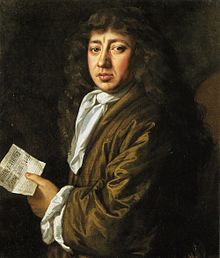
Back Samuel Pepys Afrikaans صموئيل بيبس Arabic صموئيل بيبس ARZ Самюъл Пийпс Bulgarian Samuel Pepys Catalan Samuel Pepys Czech Samuel Pepys Welsh Samuel Pepys Danish Samuel Pepys German Samuel Pepys Esperanto
Samuel Pepys | |
|---|---|
 Portrait by John Hayls, 1666 | |
| 6th President of the Royal Society | |
| In office 1 December 1684 – 30 November 1686 | |
| Preceded by | Cyril Wyche |
| Succeeded by | John Vaughan |
| Member of Parliament for Harwich | |
| In office 1685–1689 | |
| Preceded by |
|
| Succeeded by |
|
| In office 1679–1679 | |
| Preceded by | |
| Succeeded by |
|
| Member of Parliament for Castle Rising | |
| In office 1673–1679 | |
| Preceded by | |
| Succeeded by | |
| Personal details | |
| Born | 23 February 1633 City of London, England |
| Died | 26 May 1703 (aged 70) Clapham, Surrey, England |
| Resting place | St Olave's, London 51°30′39″N 0°04′47″W / 51.510878°N 0.079627°W |
| Political party | Tory |
| Spouse | |
| Relatives |
|
| Education | |
| Alma mater | Magdalene College, Cambridge |
| Occupation |
|
| Known for | Diarist |
Samuel Pepys FRS (/piːps/;[1] 23 February 1633 – 26 May 1703) was an English diarist and naval administrator. He served as administrator of the Royal Navy and Member of Parliament, but is most remembered today for the diary he kept for almost a decade. Though he had no maritime experience, Pepys rose to be the Chief Secretary to the Admiralty under both King Charles II and King James II through patronage, diligence, and his talent for administration. His influence and reforms at the Admiralty were important in the early professionalisation of the Royal Navy.[2]
The detailed private diary that Pepys kept from 1660 until 1669 was first published in the 19th century and is one of the most important primary sources for the English Restoration period. It provides a combination of personal revelation and eyewitness accounts of great events, such as the Great Plague of London, the Second Dutch War, and the Great Fire of London.
- ^ "Samuel Pepys FAQ". Archived from the original on 22 May 2017. Retrieved 28 May 2017.
- ^ Ollard (1984), ch. 16.
© MMXXIII Rich X Search. We shall prevail. All rights reserved. Rich X Search